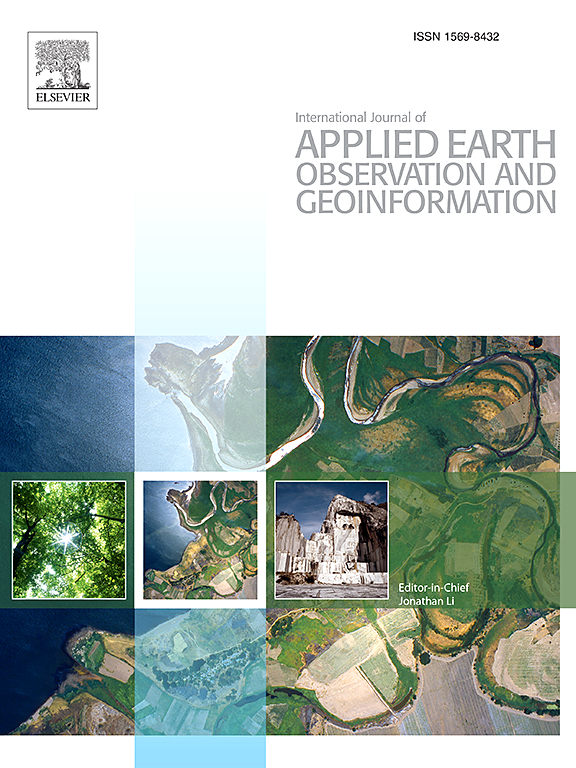InVEST-GTWR耦合模型揭示了中国山区氮磷出口的规模依赖驱动因素
IF 8.6
Q1 REMOTE SENSING
International journal of applied earth observation and geoinformation : ITC journal
Pub Date : 2025-06-30
DOI:10.1016/j.jag.2025.104705
引用次数: 0
摘要
在农业集约化和城市化快速发展的山区,非点源输出的氮和磷对水质构成了严重威胁。然而,现有的研究往往忽略了跨行政层面的多尺度分析,并且对数据稀缺山区营养物质出口的复杂驱动因素提供了有限的见解。基于生态系统服务与权衡综合评价(InVEST)模型和地理时间加权回归(GTWR)模型,构建了一个新的综合建模框架,对2000 - 2019年云南省氮磷出口动态进行了分析。我们发现2011年前后出现了一个时间转折点,2011年之前营养物质出口量下降,随后与政策变化和集约化土地利用相关的趋势上升。在空间上,高氮磷出口集群集中在人口密集、农业密集的滇中、滇东南地区,而森林覆盖的西北地区则呈现低氮磷出口集群。地级驱动因素主要是人口密度、肥料施用和工业活动,而县级驱动因素主要是耕地面积、降水和地形因素。重要的是,自然和人为因素相互作用,形成养分出口模式,强调需要空间差异化管理。InVEST-GTWR的整合反映了方法上的创新,捕捉了时空的非平稳性,并为山区有针对性的营养污染控制提供了可操作的见解,模型精度很高(地级尺度R2 = 0.98,县尺度R2 = 0.95)。本文章由计算机程序翻译,如有差异,请以英文原文为准。

Coupled InVEST-GTWR modeling reveals scale-dependent drivers of N and P export in a Chinese mountainous region
Nitrogen (N) and phosphorus (P) export from non-point sources significantly threaten water quality in mountainous regions undergoing rapid agricultural intensification and urbanization. However, existing research often neglects multi-scale analyses across administrative levels and provides limited insight into the complex drivers of nutrient export in data-scarce mountainous regions. This study presents a novel integrated modeling framework by coupling the Integrated Valuation of Ecosystem Services and Tradeoffs (InVEST) model with Geographically and Temporally Weighted Regression (GTWR) to analyze N and P export dynamics in Yunnan Province from 2000 to 2019. We reveal a temporal turning point around 2011, with declining nutrient exports before 2011 followed by a rising trend linked to policy changes and intensified land use. Spatially, high N and P export clusters occur in densely populated, agriculturally intensive central and southeastern Yunnan, while forested northwestern areas exhibit low export. Prefecture-scale drivers are dominated by population density, fertilizer application, and industrial activity, whereas county-scale drivers highlight cropland area, precipitation, and terrain factors. Importantly, natural and anthropogenic factors interact to shape nutrient export patterns, underscoring the need for spatially differentiated management. The integration of InVEST-GTWR reflects methodological innovations that capture spatio-temporal non-stationarity and provide actionable insights for targeted nutrient pollution control in mountainous regions, with high model accuracy (R2 = 0.98 at the prefecture scale and R2 = 0.95 at the county scale).
求助全文
通过发布文献求助,成功后即可免费获取论文全文。
去求助
来源期刊

International journal of applied earth observation and geoinformation : ITC journal
Global and Planetary Change, Management, Monitoring, Policy and Law, Earth-Surface Processes, Computers in Earth Sciences
CiteScore
12.00
自引率
0.00%
发文量
0
审稿时长
77 days
期刊介绍:
The International Journal of Applied Earth Observation and Geoinformation publishes original papers that utilize earth observation data for natural resource and environmental inventory and management. These data primarily originate from remote sensing platforms, including satellites and aircraft, supplemented by surface and subsurface measurements. Addressing natural resources such as forests, agricultural land, soils, and water, as well as environmental concerns like biodiversity, land degradation, and hazards, the journal explores conceptual and data-driven approaches. It covers geoinformation themes like capturing, databasing, visualization, interpretation, data quality, and spatial uncertainty.
 求助内容:
求助内容: 应助结果提醒方式:
应助结果提醒方式:


